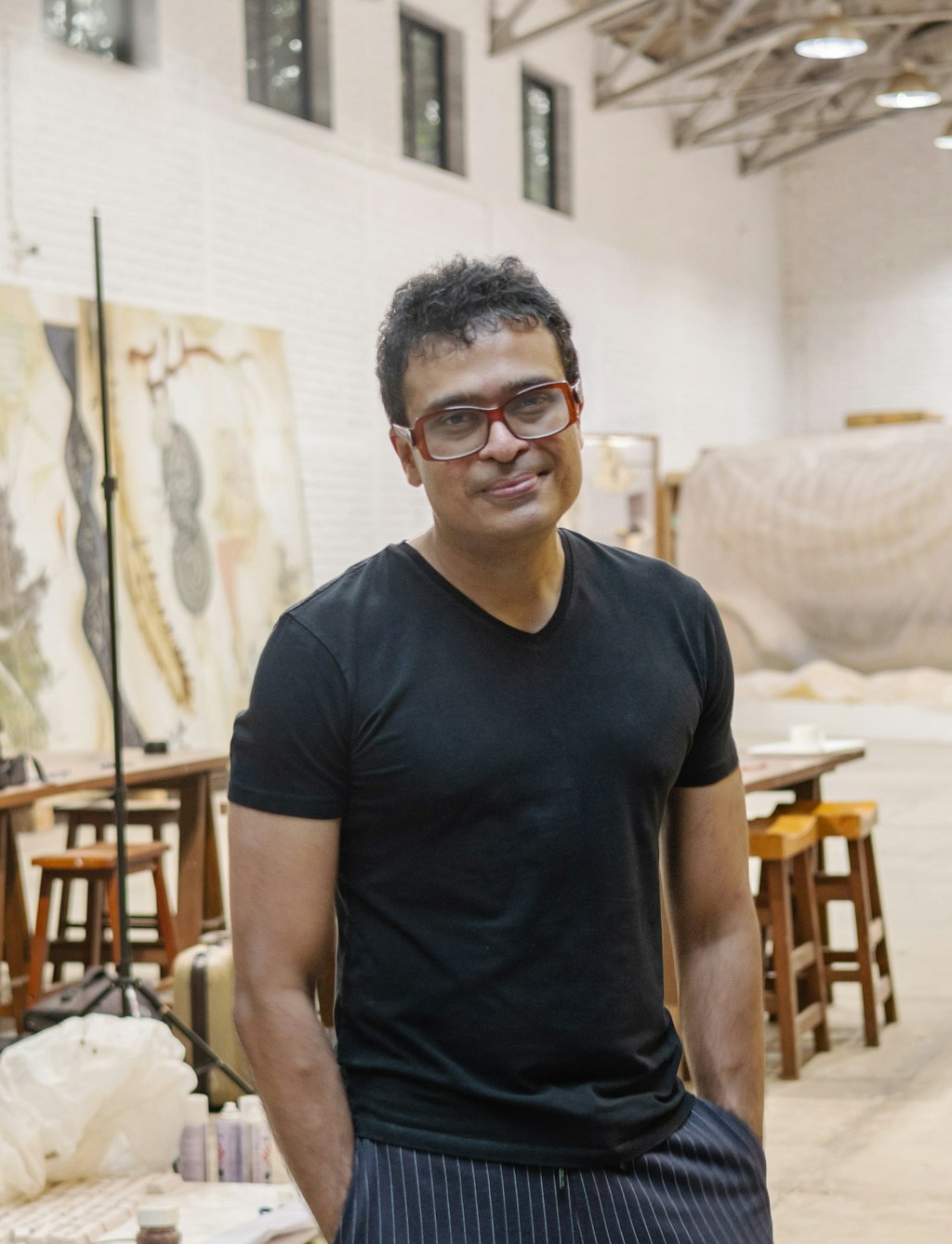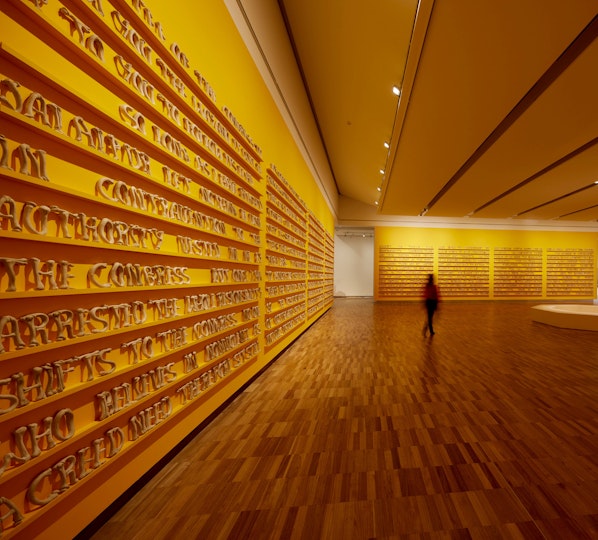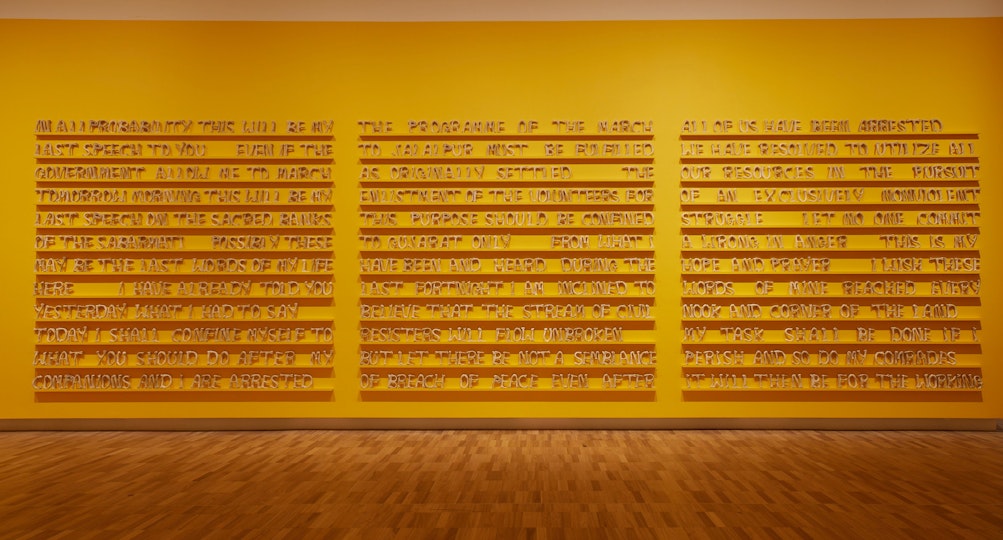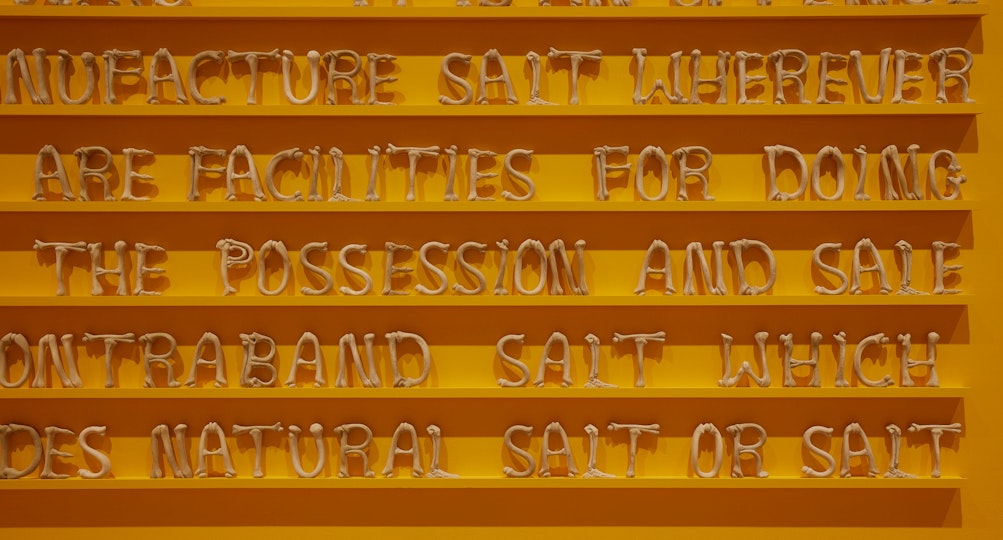Essential questions: Jitish Kallat
Indian artist Jitish Kallat, whose vast installation wraps around an entire room of the Asian Lantern galleries, spoke to Look magazine.

Jitish Kallat in his Mumbai studio, photo courtesy of the artist
Jitish Kallat in his Mumbai studio, photo courtesy of the artist
Kallat’s Public Notice 2 is installed in the exhibition Correspondence. Bones, waxen and stark against warm yellow walls, spell out Mahatma Gandhi’s speech of 11 March 1930, made on the eve of the Salt March or salt satyagraha. This non-violent protest led by Gandhi against the salt tax imposed by the colonial British Government sparked nationwide unrest and the beginning of an intensified Indian independence movement.
Cast in resin, the 4479 bone-shaped letters appear as though unearthed, remembering the violence and deaths in the lead-up to Indian Independence. Gandhi’s impassioned words are given tangible, physical form as artefacts of peaceful resistance for a new age. As Kallat has said, ‘In today’s terror-infected world, where wars against terror are fought at prime television time, voices such as Gandhi’s stare back at us like discarded relics.’
Kallat is renowned for sculptural works exploring time and our relationships with the world around us. His most recent installation melded the cosmic and the immediate, as well as the past and present, through a labyrinthine whorl of UK street signage at Somerset House in London. From his studio in Mumbai, Kallat answers some essential questions.

Detail from Jitish Kallat Public notice 2 2007 installed in the Asian Lantern galleries

Detail from Jitish Kallat Public notice 2 2007 installed in the Asian Lantern galleries

Detail from Jitish Kallat Public notice 2 2007 installed in the Asian Lantern galleries
Why do you make art?
Art making and artworks are a key part of my sense-making apparatus. Artworks do seem to take charge of their coming into being. They announce their presence in the form of subtle intuitions but then they send you off to work and engineer their making. At a deeper level, this question about making art is often a conundrum, it’s a mysterious bidirectional process – while you are making art, is the artwork also making and unmaking you?
Can you think of a cultural experience that changed the way you see the world?
I might reflect back to the early ’90s in India – more specifically, 1992. I turned 18 in the same year that cable TV was launched in India. This was a year after the liberalisation of the Indian economy. The arrival of international music and news channels, and other global broadcasters, brought the world into our living rooms. When the world’s knowledge is channeled through our cellphones today, all of this might sound trivial. But looking back, it was amazing to see one’s TV set transform from a sedate transmitter of part-time, state produced content, into a 24/7 magnet for global sound and imagery. This changed films, food and fashion, and inevitably impacted art.
Which artist/s would you like to meet now or in their lifetime?
Forgive me for making a bit of a disciplinary leap. I would love to have met Albert Einstein. His thought experiments are probably among the greatest conceptual artworks of the 20th century. Think of the classic paradox of identical twins and time dilation. One of them makes an accelerated journey into outer space and returns home to the twin who would have aged more by just remaining on Earth. Or the thought experiment of imagining oneself riding on a beam of light and seeing time slow down as you accelerate close to the speed of light. One can think of these as rich works of art, surging with paradox, fiction and speculative force, while advancing science and human understanding.
Which one Art Gallery of New South Wales collection work could you live with?
I must confess I haven’t scanned the vast Art Gallery of New South Wales collection, but I’ve applied some ‘selection bias’ as to where I was looking. To live with, I’d choose the 18th-century Seated Buddha calling the Earth to witness. The reflective gesture of the left hand in the lap and the right hand resting in the earth-touching gesture (or the bhumisparsha mudra) would be a perfect ‘object of attention’ in the studio.
What is art for?
Ideally art is an activity which is best served without attaching direct teleology or a precise end-goal. Art is a place where the unforeseen and uncertain are nurtured, where complex ideas can be addressed in a spirit of open creative play … where contexts are rearranged and meanings are renewed. Art is not only something that you look at, but it is also something that you look through. So if you ask me what is art for, I’d say it is a device for seeing the world.
A version of this article first appeared in Look – the Gallery’s members magazine